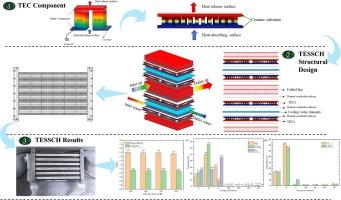基于热电冷却器的高功率、高 COP 和小尺寸新型夹层结构冷却与加热系统
IF 9.9
1区 工程技术
Q1 ENERGY & FUELS
引用次数: 0
摘要
在实际应用中,热电冷却器(TEC)的冷却能力(Qc)通常低于 200 W,冷却性能系数(COPc)小于 1,限制了其在高需求场景中的应用。尽管热电半导体制冷片结构紧凑,但在实际应用中需要大量的散热结构。本研究介绍了一种先进的热电夹层结构冷却和加热系统(TESSCH),该系统集成了热电半导体制冷片、扁平水道和折叠翅片。TESSCH 系统在 172 毫米*170 毫米*30 毫米的最大外部尺寸内集成了 72 个热电半导体制冷片,与传统的热电半导体制冷片系统相比,大大减少了占地面积。实验结果表明,TESSCH 系统的加热性能系数(COPh)是传统 PTC 加热器的 196.7%,COPh 和加热能力(Qh)值分别为 2.18 和 1088.82 W。在输入功率为 500 W 的情况下,TESSCH 系统的 COPc 和冷却能力(Qc)分别达到 1.18 W 和 588.82 W,超过了典型的 TEC 数据。与传统的空气-水冷却系统相比,TESSCH 以更紧凑的外形大大提高了性能。利用有效值法和 BBD 实验设计,得到了响应变量与设计变量的回归模型。通过优化方法获得了设计参数的最佳组合。本文章由计算机程序翻译,如有差异,请以英文原文为准。

A novel sandwich-structural cooling and heating system with high power, high COP and small size based on thermoelectric cooler
In practical settings, thermoelectric coolers (TEC) typically exhibit a cooling capacity (Qc) below 200 W and a coefficient of cooling performance (COPc) less than 1, limiting their application in high-demand scenarios. Despite their compactness, TEC require extensive heat dissipation structures in actual deployment. This study introduces an advanced thermoelectric sandwich-structural cooling and heating system (TESSCH), integrating TEC, flat water channels, and folded fins. The TESSCH system incorporates 72 TECs within a maximum external dimension of 172 mm*170 mm*30 mm, significantly reducing the footprint compared to traditional TEC system. Experimental findings reveal that the TESSCH system’s coefficient of heating performance (COPh) is 196.7 % of that provided by a conventional PTC heater, achieving COPh and heating capacity (Qh) values of 2.18 and 1088.82 W, respectively. Under an input power of 500 W, the TESSCH system’s COPc and cooling capacity (Qc) reach 1.18 and 588.82 W, surpassing typical TEC figures. Compared with traditional air–water cooling systems, TESSCH offers substantially enhanced performance in a more compact form. Using RMS method and BBD experimental design, the regression models of the response variables about the design variables were obtain. The optimal combination of design parameters is obtained by the optimization method.
求助全文
通过发布文献求助,成功后即可免费获取论文全文。
去求助
来源期刊

Energy Conversion and Management
工程技术-力学
CiteScore
19.00
自引率
11.50%
发文量
1304
审稿时长
17 days
期刊介绍:
The journal Energy Conversion and Management provides a forum for publishing original contributions and comprehensive technical review articles of interdisciplinary and original research on all important energy topics.
The topics considered include energy generation, utilization, conversion, storage, transmission, conservation, management and sustainability. These topics typically involve various types of energy such as mechanical, thermal, nuclear, chemical, electromagnetic, magnetic and electric. These energy types cover all known energy resources, including renewable resources (e.g., solar, bio, hydro, wind, geothermal and ocean energy), fossil fuels and nuclear resources.
 求助内容:
求助内容: 应助结果提醒方式:
应助结果提醒方式:


